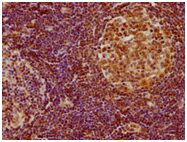Human HHEX was initially isolated from hematopoietic tissue, and is present in several hematopoietic progenitors, where its expression is down-regulated during terminal cell differentiation. HHEX is also expressed in the anterior visceral endoderm during early mouse development, and in some adult tissues of endodermal origin, including liver, lung and thyroid. Hex plays a critical role in inducing differentiation of vascular endothelial cells, in the development and maintenance of several organs derived from foregut endoderm, such as the lung, liver and thyroid gland, and in thyroid cell differentiation. Hex also mediates transcriptional induction of the SMemb/NMHC-B gene via its homeodomain and can function as a transcriptional modulator of CRE-dependent transcription in vascular smooth muscle cells (VSMCs). Hex, a soluble protein, is detected in both the nucleus and cytoplasm of transfected and nontransfected cultured cells.
Clone
Polyclonal
Isotype
IgG
Host species
Rabbit
Species Reactivity
Human
Cellular Localization
nucleus
Positive Control
lymph node
Applications
ELISA, IHC
Intended Use
Research Use Only

